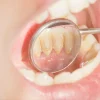Get information about Inlay and Onlay Ceramic Fillings treatment with the explanation of specialist dentist Merve Özkan Akagündüz.
Ceramic Inlays & Onlays

Inlay and Onlay Fillings, Doredent İstanbul
Inlay and onlay ceramic fillings are restorations preferred in cases where there is significant tooth structure loss, but not to the extent that a full crown is necessary. They can be described as a type of restoration that falls between a filling and a crown.
Inlay ceramic fillings are applied to restore tooth losses that do not include the peaks of the tooth called cusps. Inlay fillings are an alternative to direct filling methods and are preferred for their advantages.
Onlay ceramic fillings are used when there is more extensive material loss in the tooth, resembling a crown but not encasing the tooth from every angle like a crown does. Based on the extent of decay and the structure of the tooth, they are custom-made in a laboratory.
Both inlay and onlay fillings can be made from ceramic, gold, or composite filling materials. Being manufactured outside the mouth ensures they are more durable and better polished than direct fillings, allowing them to absorb chewing forces better.
Advantages of Inlay and Onlay Ceramic Fillings
Inlay and onlay fillings are highly durable against chewing forces. There is no need to remove healthy tooth tissue beyond the decayed areas for their placement. They are usually made entirely of ceramic and are highly aesthetic. Unlike direct composite fillings, they do not undergo polymerization shrinkage. Their wear rates are much lower. Since polishing is more successfully performed in a laboratory setting, they offer significant advantages in terms of aesthetics and stain resistance. They are tough to distinguish from natural tooth tissue. Regular daily oral hygiene is sufficient for maintenance, and they do not require extra care. They can be used for many years without issues.
Disadvantages of Inlay and Onlay Ceramic Fillings
There are no aesthetic or functional disadvantages to inlay and onlay ceramic fillings. Their biggest disadvantage is their higher cost. They are approximately 3-4 times more expensive than direct composite fillings. This is due to the need for impression-taking, the addition of laboratory costs, the higher cost of adhesive systems, the longer time required, and the need for a more precise operation.
How Are Inlay and Onlay Ceramic Fillings Made?
The process of making inlay and onlay ceramic fillings is quite similar to that of making crowns. The critical difference is that while crown preparation requires circumferential tooth reduction, inlay, and onlay fillings do not require such extensive preparation. Preserving as much of the tooth structure as possible is crucial. Only the affected areas of the tooth are cleaned. Then, impressions are taken either traditionally or digitally and sent to a laboratory. A temporary filling protects the tooth from damage and sensitivity issues until the laboratory processes are completed. Once the inlay or onlay fillings are ready, the temporary filling is removed, and the inlay or onlay is tested in the mouth. The bonding process begins once it is confirmed to fit correctly and harmonize with the tooth. This bonding process is specialized and precise, requiring careful and correct execution.
Merve Özkan Akagündüz
I was born in Edirne in 1988. In 2007, I began my master’s degree in Dentistry at Istanbul University (Çapa) Faculty of Dentistry and graduated in 2012.
In 2014, I started my specialization in the Department of Orthodontics at Süleyman Demirel University Faculty of Dentistry. In 2019, I earned the title of Orthodontist and was appointed to Çorlu ADSM, where I worked as an Orthodontic Specialist Dentist from 2019 to 2022.
As of 2024, I have been continuing my practice in my own clinic.








